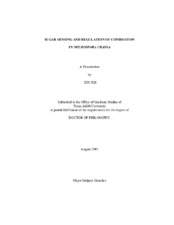| dc.description.abstract | The orange bread mold Neurospora crassa is a useful model for the study of filamentous fungi. One of the asexual reproduction cycles in N. crassa, macroconidiation, can be induced by several environmental cues, including glucose starvation. The rco-3 gene is a regulator of sugar transport and macroconidiation in N. crassa and was proposed to encode a sugar sensor (Madi et al., 1997). To identify genes that are functionally related to RCO-3, three distinct suppressors of the sorbose resistance phenotype of rco-3 were isolated and characterized. The dgr-1 mutant phenotypically resembles rco-3 and may be part of the rco-3 signaling pathway. Epistatic relationship among rco-3, dgr-1 and the suppressors were carried out by analyzing rco-3; dgr-1 and sup; dgr-1 double mutants. These analyses indicate that rco-3 is epistatic to dgr-1.
A cDNA microarray containing 1363 N. crassa genes was generated to examine the transcriptional response of wild type cells grown in the presence of glucose or starved for glucose for two hours. Comparing N. crassa profiling data with the published diauxic shift data from S. cerevisiae (DeRisi et al., 1997) revealed that S. cerevisiae and N. crassa share a similar, but not identical, transcriptional response pattern for genes belonging to central carbon metabolism. The microarray results indicate that N. crassa utilizes glucose through fermentation and respiration simultaneously in aerobic culture, a finding that is consistent with previous measurements of ethanol production and enzyme activities in N. crassa. The same microarray was used to examine the transcriptional response to glucose status in rco-3 and dgr-1 mutants. The two mutants display similar expression patterns for most of the genes on the microarray supporting a close functional relationship between them. In addition, I identified a high affinity glucose transport gene in N. crassa, whose transcription is under the control of glucose, rco-3 and dgr-1. | en |


